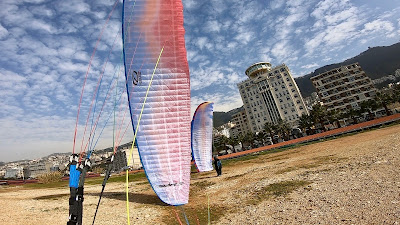Notes: In 2018-19, lots of manufacturers are delivering very nice gliders. In the B category, it’s difficult sometimes to say which glider has a better glide or better climb as they are very close. At least among the top 5 of the category .
 The tests are becoming sometimes awkward to write, when new gliders still open my eyes for their better overall behavior…But we are lucky to have them, and i’m also super pleased to fly them :-)
The tests are becoming sometimes awkward to write, when new gliders still open my eyes for their better overall behavior…But we are lucky to have them, and i’m also super pleased to fly them :-)
Ozone Swift 5 size S
I already test flew the Rush 5 in size S. The Swift 5 is the light version.
The cloth used on the Swift 5 is really light ! The glider weights 3680 grams on my scale !
The Swift 5 launches without any effort even in nil wind. The Rush 5 heavy cloth needed a steady pull, but the swift 5 launches effortlessly.
There are also many differences with the Rush 5 concerning agility, brake pressure and feel.
The Swift 5 has a softer feel through the brakes, more precise, and linear. It is also more agile than the Rush 5 size S similarly loaded. Coring thermals is direct and a real pleasure. The turning radius could be done very tight. Flew the Swift 5 with the GTO light and then with the Delight 3.
The GTO light delivers a super agile feel and great handling. The Delight 3 is more stable in roll, but the Swift 5 still feel quite agile in turns on it also !
As i already mentioned in my earlier writings, that the Rush 5 doesn’t have that super agility, but still very efficient in thermals. The Swift 5 is now an agile glider while it retains the excellent climb rate of the Rush 5.
The efficiency in thermals are second to none ! In very weak stuff on the loaded S size at 84 all up, i could benefit from every little scrappy thermal. In strong thermals, the Swift 5 compensate the turbulent air, by a stable, well balanced glider behavior. All that leads to a quick climb, without any bad reactions of pitch, or dive and loosing height. Probably, the light fabric smoothen the reactions. That’s why, IMHO, the Swift 5 has a high efficiency in the air.
I flew and glided next to my reference 6.3 high-end ‘C’ gliders, and I was impressed by the excellent glide ratio of the Swift 5 even comparing them at half the speed range ! A marvel indeed !
Like the Rush 5, the Swift 5 efficient glide in moving air seems extraordinary ! The Swift 5 floats and advances through the airmass with flawless efficiency.
To put it into simple words, the Swift 5 self-automated movements through moving air, seems to glide very close to the class above !
For sure the top C class gliders will have that slight edge to dig through and move forward faster, like the Q-Light or the Delta 3. Comparing the Swift 5 to a top C is not fair, but i just want to make a point that those high B’s are super close and quite efficient in the hand of good pilots. and the decision for week end pilots to change for a C glider just to have ‘more performance’ is not always a good choice unless the pilots can extract those performances and wants more feel that a C can deliver.
The trim speed though is not as fast, and could be slightly around 38 km/h. The top speed is 12 km/h over trim on the S size taken at 1000 ASL.
 The Swift 5 gives informations about what’s the air is doing more than the Rush 5. The Rush 5 feels more as a block and sometimes well dampened. The Swift feels more as a butterfly and needs slightly more active piloting in rough air. For a high B pilot, it’s easy to fly.
The Swift 5 gives informations about what’s the air is doing more than the Rush 5. The Rush 5 feels more as a block and sometimes well dampened. The Swift feels more as a butterfly and needs slightly more active piloting in rough air. For a high B pilot, it’s easy to fly.
Ears are stable, and reopen without input.
Conclusion: This review was written after talking with three of my friends who also flew the Swift 5 ! Not because i wasn’t sure what to write, but in order to see their faces after landing and to listen to their interesting comments :-). They were all fascinated by what that glider was doing in the air.
Some gliders deliver a complete package of handling, comfort, glide and climbing efficiency. The Swift 5 holds that package but in ‘premium’ !
As i always say, the above written letters remains just letters on a screen. My humble small suggestion, is to get a demo Swift 5, load it near the top, then please write your opinion ! :-)
I’m really curious ;-)
This is only my opinion. Make your own !





























